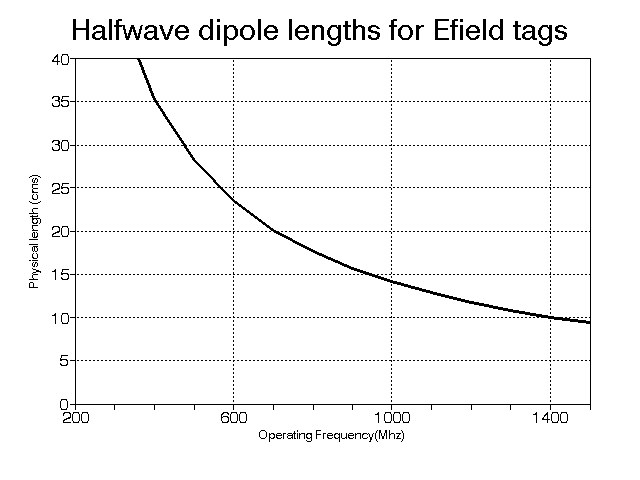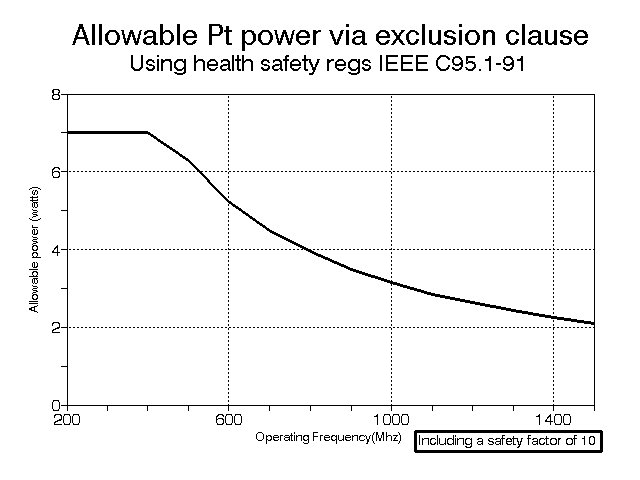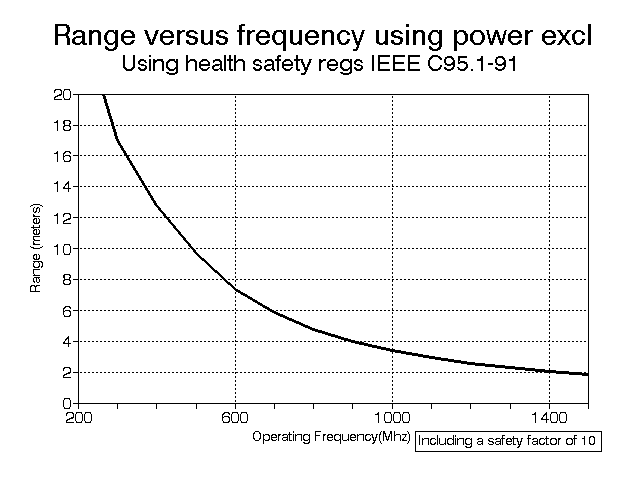

 Trolley Scan(Pty) Ltd
Trolley Scan(Pty) Ltd
Trolleyponder(TM)
Range versus power and frequency for passive electric coupled tags
RFID tags offer different range performance depending on the choice of operating frequency!
RFID transponder (tag) systems commonly have operating frequencies as low as 60KHz and as high as 5.8GHz, a factor of nearly 1 million times. It is necessary to understand why there is such a frequency diversity so that the correct operating conditions can be chosen for the desired application.
Electromagnetic propogation, by which energy is transferred at radio frequencies, has a magnetic field mode and an electric field mode. The magnetic mode is generally preferred for operating frequencies below 100 MHz, which also allows the use of antenna systems that comprise small coils. The electric field mode is preferred for frequencies above 100 MHz (the exact frequency of change over is not critical) as the antenna structures for electric field coupling start to become practical for tagging above this frequency. For example for an electric field coupled mode, a typical half wave dipole antenna's length would be:
15000
Length in centimeters = ----------------------------
(Operating frequency in MHz)

For magnetic mode systems, ranges much further than 0.5 meters are very
rare, and in many systems the operating range is only a couple of centimeters.
The range is a function primarily of how wide the reader antenna can spread
the lines of flux from its oscillating North/South poles as energy is transferred
to the tag by the means of the oscillating lines of flux passing through
the coil of the transponder. To spread the lines of flux, the antenna sizes
generally need to be large, and for example can be the size of a doorway
for access control applications.
The remainder of this note will deal with electric field tagging systems operating above 100 Mhz.
In the mission to produce low cost transponders, it is desirable for the transponders to receive their operating power from the energising field radiated by the reader. Such transponders(tags) are referred to as passive transponders. Active transponders are those that include an onboard battery to provide their operating power as against their data communication requirements which are contained in the electromagnetic radiated signals between the reader and transponder.
Therefore for transponders to be passive they need to collect sufficient of the radiated energy of the reader which they can rectify and which must exceed their minimum operating voltage conditions.
For electric mode systems the following process happens.
The transmitter in the reader radiates via the transmit antenna its energy. This energy radiates at the speed of light from the antenna outwards in all direcctions. At any distance from the transmitter, the energy per square unit would be equal to the radiated energy (times the antenna gain) divided over the surface area of a sphere which has a radius equal to the range at which the density is being measured.
In mathematical terms:
Pt * Gt
Energy density (W/sq m)= ----------------------------
4 * PI * range(m)*range(m)
Where
Pt is the transmitted energy
Gt is the antenna gain
PI is 3.14159
Range is distance from antenna
The energy available at the transponder is the energy that can be collected in the EFFECTIVE APERTURE of the transponder
In mathematical terms:
Energy received(W)= Energy density at range(W/sqm)*Effective aperture(sqm)
This energy is transformed via the antenna of the transponder to its operating impedance and can be rectified to produce the operating voltage for the transponder.
The effective aperature of the transponder is a function of the gain of the transponder antenna and the square of the operating wavelength (speed of light/operating frequency)
Assuming gains of antennae, and minimum operating voltage for the transponder and its matching are constant in all situations, then the operating range of the system is a function of the transmitted power and the operating wavelength (that is inverse frequency).
Operating power vs frequency
The amount of power that can be used or such an application is governed
by health and safety requirements and also by local regulation. The local
regulation is primarily to introduce order between users and communities,
while the health issues relate to safety of systems. The purpose of this
paper is to show the effects of choice of frequency on range, range here
being relative to other frequency choices. The absolute range will be governed
by the factors of the particular design of the system, factors such as
local regulation, antenna matching, antennae gains etc. For this reason
we will work from a health and safety point of view as to what is safe
and then show the relative variations in range with choice of frequency.
In the United States the IEEE Standards Coordinating Committee 28 on Non-Ionizing Radiation Hazards has sponsored the standard
IEEE C95.1-1991 - IEEE Standard for Safety Levels with Respect to Human Exposure to Radio Frequency Electromagnetic Fields, 3kHz to 300 GHz
This has been approved by the IEEE Standards Board and the American National Standards Institiute.
This standard set guidelines for exposing humans to RF radiation in a variety of conditions (it is 76 pages long), in almost all cases expressed as a power density or Electric Field Strength. In clause 6.10 they detail an exclusion in the form of a Pt of a transmitter, such as might be the case in a cell phone or a mobile radio. The following graph shows the allowable power exclusion of this clause, which still maintains safety factors in excess of 10 times.

Transmitter power allowable versus frequency based on the exclusion clause 6.10 of IEEE C95.1-1991 ensuring a safety factor of at least 10 times
The rationale for specifying a power rather than a field or power density, is that no matter what the gain of the transmitter antenna might be, using this exclusion the maximum power that can be received by the human body is only 7 watts which will not exceed the recommended dose levels.
Using these power curves which show relative Pt versus frequency and using the relationship for effective aperture versus frequency, and assuming all other factors such as antenna gains and minimum operating voltages remain constant with frequency; and calibrating the graph on an absolute basis to give a 4 meter range at 915 MHz (which is a practical value of some designs), the following graph shows maximum range versus frequency for PASSIVE electric field tags.

Graph of maximum range versus frequency for passive electric field tags
using a Pt with at least a 10 times safety factor
What the calculations show is that for really long range passive tag operation you need to operate in the 100Mhz to 500Mhz range.By extrapolating this graph, for frequencies at 2.45Ghz and above, the ranges are likely to be much less than 1 meter and it is likely that active tags will be needed.
Conclusion
The above graph shows the sensitivity of range of a low cost passive
transponder system to the choice of operating frequency based on health
considerations. It is possible to improve these data by system design,
or by just screening off the application to keep the humans out of the
radiation zone. Despite RFID transponders having an operating frequency
span from 60kHz to 5.8Ghz, it is difficult to get operating ranges for
passive transponder systems in excess of 1 meter if the operating frequency
lies outside the range of 100Mhz to about 1800Mhz. However frequencies
are allocated by regulatory bodies and any choice would be dependent on
their regulations.
The Trolleyponder components for the tag are specified to operate as passive transponders at frequencies between 100Mhz and 1600Mhz.
Mike Marsh
6 November 1998
Subsequent to the publication of this article, Trolley Scan have developed and are licensing the EcoTag energy conversion system for transponders which allows up to a further 60 fold power reduction for passive transponders.